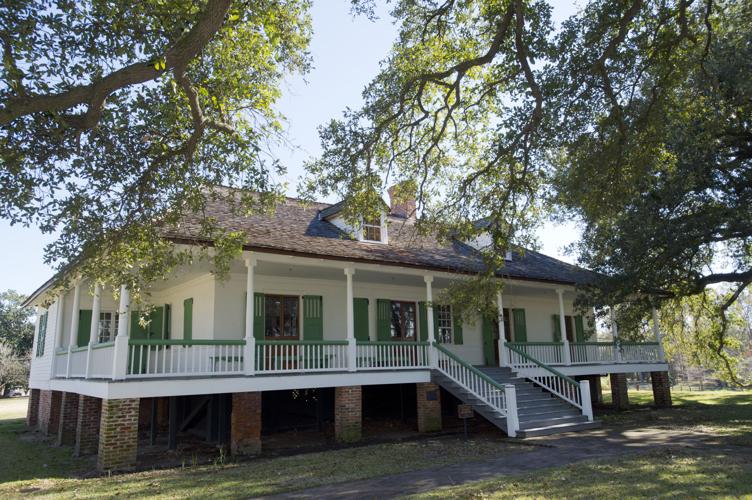When a reader asked, "What is the oldest standing building in Baton Rouge?" most assumed it would be one of the old downtown buildings — maybe the Pentagon Barracks or something associated with the Old State Capitol.
"There is some information online that suggests the Tessier Building downtown dates to the 1760s, but we don't have any documentation to confirm that date," said Bailey Hall, national register coordinator with the Division of Historic Preservation at the Louisiana Office of Cultural Development.
The confirmed oldest standing building in Baton Rouge isn't downtown.

This is what Magnolia Mound Plantation House looked like in 1966, when efforts to save the historic home began.
Instead, according to the , Magnolia Mound Plantation House is the oldest documented extant building in the area, tucked away at 2161 Nicholson Drive. The site was originally part of a 900-acre 1785 Spanish land grant, and the main house was built by an Irish settler in 1791.
BREC's Magnolia Mound, with an architectural classification of French Creole, includes the main house and surrounding 16 acres, which serve to educate the public about the lifestyle that formed the culture of Louisiana influenced by early settlers from France and the West Indies.
The plantation once grew indigo, then cotton and sugar.
From 1802 to 1805, the main house was enlarged and renovated. In the early 19th century, the site was home to Constance Duplantier and Armand Duplantier, a French military officer and aide-de-camp to the Marquis de Lafayette.

Jeanette Brock, a tour guide with Magnolia Mound, points to artifacts in the main house in 2023.
"During that particular time, details such as a rare cove ceiling and Federal style woodwork were added," states about the renovations. "Surrounded by many aged live oaks, the plantation house has retained its Creole plan and character for over 200 years. It is constructed of cypress beams with bousillage-entre-poteau and the original cypress flooring."
In 1966, BREC purchased the historic house museum to save it from demolition.
"After a nine-year restoration with the assistance of the Friends of Magnolia Mound, BREC opened the museum house to the public in May 1975," said John Sykes, Magnolia Mound's special facility manager. "In 1976, BREC received a bicentennial grant from the U.S. government for the entire purchase price."
This year marks the 50th anniversary of the museum's opening.
When visitors arrive to the grounds, they can choose to participate in a guided tour of the main house and open hearth kitchen or a self-guided tour. The site also includes a gift shop, diorama of the grounds and two educational videos to watch in the Turner Family Visitor Center.

Magnolia Mound volunteer Jessica Kemm shows an old version of a toaster used back when the house was originally built in the late 1700s.
Inside the open-hearth kitchen, the outdoor scullery is furnished with vintage utensils like a waffle iron and sugar snippers. Other structures on the property include:
- Quarters: a double slave cabin quarters built circa 1830, originally from Cherie Quarters at Riverlake Plantation in Pointe Coupee Parish
- Pigeonnier: a small structure used to house various game birds, built circa 1825, originally from Barthel Plantation in Iberville Parish
- The overseer's house: built circa 1871, original to the grounds and used as a home for the man who was responsible for the plantation's various operations
- Privy: a three-seat outhouse from the mid-19th century, originally from Rosebank Plantation in West Feliciana Parish

Visitors of Magnolia Mound can choose to participate in a guided tour of the main house and open hearth kitchen or do a self-guided tour. However, a self-guided tour does not include entrance into the main house, as it holds a multi-million-dollar collection of art and furniture.
In the main house, a multimillion-dollar collection of art and furniture showcases items from the state's colonial period, textiles, crystal and English and French ceramics.
"Spanning the colonial era and early statehood, Magnolia Mound's collection of furnishings and decorative arts include one of the foremost public groups of Louisiana-made objects, in carefully restored and documented settings," states.
Throughout the year, Magnolia Mound offers workshops, lectures and festivals. In December, it hosts Creole Christmas, a free event that invites artisans, historic dancers and entertainment during the holiday season.
"As a former place of enslavement," Sykes said, "Magnolia Mound: Museum and Historic Site seeks to tell the stories of all its residents and their impact on our state's history and culture."









